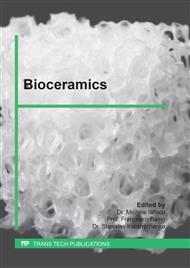p.63
p.69
p.75
p.81
p.87
p.93
p.99
p.105
p.111
Assessing the Physical-Mechanical Characteristics of Hydroxyapatite-Titanium Oxide Biocomposites Produced by the Polymeric Wax Addition Method
Abstract:
The aim of the present study is to assess the physical-mechanical properties of hydroxyapatite-titanium oxide composites used in porous scaffolds produced by the polymeric wax addition method. Mixtures composed of 50%-50%wt. (sample A), 60%-40%wt. (sample B), and 70%-30%wt. (sample C) of hydroxyapatite-titanium oxide were prepared. Subsequently, 70%vol. of each sample was combined with 30%vol. polyethylene wax. Forty-five (45) specimens per composition (12 mm diameter and 10 mm height) were prepared through uniaxial pressing. The specimens were subjected to calcination at 500°C (1°C/min) and left to rest for 1 h for polymeric wax elimination. Next, they were sintered at 1250°C, 1300°C, and 1350°C for 2 h. Physical-mechanical assays were conducted to assess apparent porosity, water absorption, specific gravity, firing linear retraction, and ultimate compression strength. As temperature increased, firing linear retraction, specific gravity, and ultimate compression strength increased in all samples, whereas water absorption and apparent porosity decreased. Sample A presented the highest densification and ultimate compression strength rates at 1350°C. Overall, the physical-mechanical characteristics of these composites made them suitable to be used as biocomposites.
Info:
Periodical:
Pages:
87-92
Citation:
Online since:
June 2019
Price:
Сopyright:
© 2019 Trans Tech Publications Ltd. All Rights Reserved
Share:
Citation:



